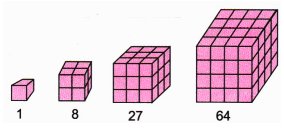Patterns In Mathematics Class 6 Questions and Answers - Free PDF Download
FAQs on NCERT Solutions For Class 6 Maths Chapter 1 Patterns In Mathematics Exercise 1.3 - 2025-26
1. What concepts are covered in NCERT Solutions for Class 6 Maths Chapter 1 Exercise 1.3?
The NCERT Solutions for Class 6 Maths Chapter 1 Exercise 1.3 focus on recognising, visualising, and analysing different types of number sequences, including triangular numbers, square numbers, cubes, and hexagonal numbers. The exercise strengthens problem-solving by teaching students to spot mathematical patterns and understand how sequences evolve as per CBSE 2025–26 guidelines.
2. How do the solutions for Class 6 Maths Patterns in Mathematics Exercise 1.3 support CBSE exam preparation?
These NCERT Solutions follow the CBSE methodology, providing step-by-step explanations for identifying and extending number patterns. Practicing these builds the analytical skills needed for CBSE-style questions, ensuring students can tackle related concept-based questions confidently in the 2025–26 exams.
3. Why are some numbers called triangular, square, or cube numbers in Chapter 1 Maths Class 6 solutions?
- Triangular numbers: Formed by arranging objects in a triangle. For example, 6 can make a triangle with 3 rows.
- Square numbers: Result from multiplying a number by itself (2 × 2 = 4). Represent areas of squares.
- Cubes: Found by multiplying a number by itself twice (2 × 2 × 2 = 8). Represent volumes of cubes. These definitions, given in NCERT Solutions, help students visually relate to number patterns in Class 6 Maths.
4. What is the significance of visualising number sequences in NCERT Solutions for Class 6 Maths Chapter 1?
Visualising number sequences helps students recognise how numbers progress, predict future terms, and understand deeper mathematical connections. The ability to see these patterns is critical for problem-solving and for grasping advanced maths concepts as outlined in the CBSE Class 6 2025–26 syllabus.
5. How can incorrect pattern recognition affect solving problems in Class 6 Maths Chapter 1?
If students misidentify a pattern (for example, mistaking an arithmetic sequence for a geometric one), they may apply the wrong rule and get incorrect answers. The NCERT Solutions demonstrate the correct methodology, helping students avoid such misconceptions in pattern-based questions.
6. What strategies are suggested in NCERT Solutions for solving number pattern questions in Exercise 1.3?
- Look for a consistent rule or relationship between numbers (add, multiply, etc.).
- Check if the change between numbers is constant (arithmetic) or a factor (geometric).
- Pictorially represent sequences to spot patterns visually.
- Use stepwise reasoning as shown in solutions to ensure logical accuracy.
7. What type of number patterns are classified as hexagonal numbers in Class 6 NCERT Solutions?
Hexagonal numbers are a special sequence where the difference between terms increases by multiples of 6. For example: 1, 7, 19, 37, etc. Each term is built by adding 6 more than was added to get the previous term. NCERT Solutions guide students to identify and extend such patterns.
8. How do the NCERT Solutions help in mastering skipped logic or missing terms in number sequences?
NCERT Solutions highlight how to identify the underlying logic even when sequence terms are missing. By focusing on consistent steps or differences, students learn to predict missing numbers and explain their reasoning, which is crucial for full marks in the CBSE 2025–26 format.
9. How can students avoid common errors in Exercise 1.3 of Class 6 Maths Chapter 1?
- Always check the rule for every part of the sequence before answering.
- Draw pictorial or item-wise representations as suggested in NCERT Solutions.
- Verify answers by reconstructing the pattern from the identified rule.
- Read each question carefully to determine the type of pattern (triangular, square, etc.).
10. How do NCERT Solutions for Class 6 Maths Chapter 1 build a foundation for higher mathematics?
By consistently working through different number sequences and patterns, students develop analytical thinking and reasoning skills. These are the building blocks for advanced topics such as algebra and series, forming a strong base for future learning as per the Class 6 Maths curriculum for 2025–26.
11. What should a student do if they struggle with visualising number sequences in Exercise 1.3?
Students should revisit the pictorial representations provided in the NCERT Solutions, try drawing each sequence step-by-step, and compare their approach with the methods shown. Practicing with the given solved examples and referring to the reasoning will help improve pattern recognition.
12. How are practice problems structured in Class 6 Maths Chapter 1 NCERT Solutions to reinforce learning?
The practice problems are arranged in increasing order of difficulty. Each problem encourages logical deduction, proper application of sequence rules, and offers detailed, stepwise solutions to strengthen understanding of Patterns in Mathematics for CBSE Class 6.
13. What are some common CBSE exam questions based on Class 6 Maths Chapter 1 number sequences?
CBSE often asks students to:
- Identify the next term in a given pattern.
- Explain why a number is triangular, square, or a cube.
- Draw representations for number patterns.
- Find missing terms in a sequence using proper logic.
14. How often should students practise number pattern problems from NCERT Solutions for best results?
Regular practice is advised—working through a few problems daily or every alternate day helps solidify understanding, supports long-term retention, and ensures readiness for CBSE 2025–26 Maths exams.


































